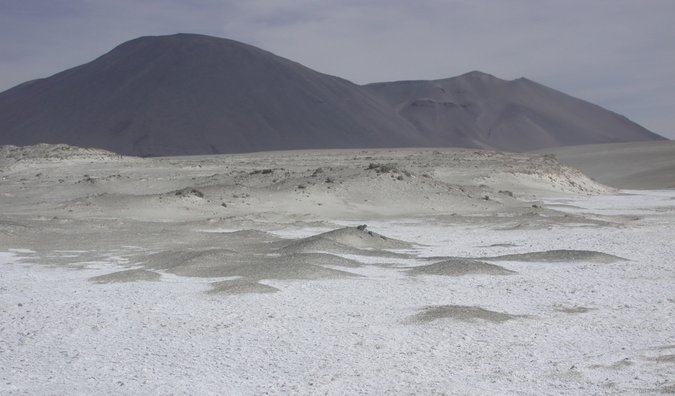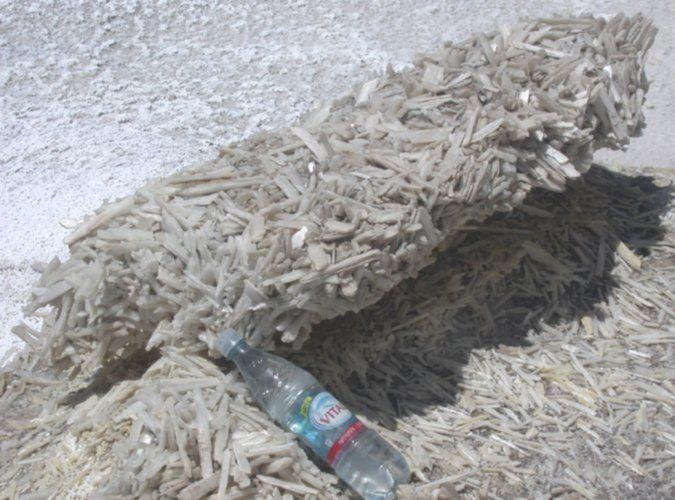Crystal whirlpools on the top of the Andes, an unprecedented phenomenon in history
Scientists have discovered a new form of cyclone that is gradually forming in the Andes region of South America. This bizarre natural phenomenon is the explanation for the mass phenomenon of crystal-hard rock crystals mysteriously appearing along the sand dunes here.
- Decode the mysterious "dead zone" inside of the tornado
- Decode the secrets of the dragon's hose, the new scary natural phenomenon appeared in Khanh Hoa
Strange phenomenon has 1 - 0 - 2
The Andes range is considered to be a natural border between Chile and Argentina, where there is a mountain area called Salar de Gorbea, known for its dry climate and rare rain. Especially, there are sand dunes with thousands of crystal stone crystals creating a surreal landscape.

Sand dunes covered with crystal.
So where do these stone crystals come from? This is a question that challenges all geographic records of scientists around the world.
Find the answer
According to scientists, these milky white crystalline fragments are formed in salty acid volcanic lakes. And the nearest place can "spread" these crystals away from the Salar de Gorbea desert where they are detected a minimum distance of 5 km. So how can they travel such a long distance?
Kathleen Benison, a geologist from West Virginia University, found tornadoes moving from the valley area, where saline acid pools reached the dunes and weakened and vanished. This phenomenon occurs regularly in the afternoons and they themselves suck up nearly 30 centimeters of crystal pieces from saline acid pools in the valley and pull them into sand dunes.
 Strange whirlwind known as Mo Devil.
Strange whirlwind known as Mo Devil.
Giant tornadoes can reach several kilometers high, about 500 meters in diameter and are composed of crystals that make Kathleen set for this strange phenomenon, the Devil, a form of extreme cyclone of low intensity. these take place for a long time.
When reaching the dunes, the tornadoes weaken, the crystals will slowly free up from a height of 4.5m.
Usually if a whirlwind can attract "heavy objects" it rarely happens and they must have intensity and wind power up to historical figures. In fact, the world appeared a tornado called the Devil's Dust that created a "rain" of rats throughout the Arizona desert.
 A block of ice crystals in the Andes.(Photo: Science Alert.)
A block of ice crystals in the Andes.(Photo: Science Alert.)
But according to the report, up to this point, the tornadoes in the Andes only achieved wind speeds of 70 km / h - the same as the tornado F0. At this rate, the possibility of a tornado capable of drawing crystals into the air is impossible. That is, the crystal vortex phenomenon in the Andes might be something scientists have never known before.
Kathleen Benison hypothesized that low air pressure in the Salar de Gorbea desert, along with the long shape of the crystal fragment, made it easy to "suck" into the air and fly at a few altitudes. kilometers.
And if what Kathleen Benison makes is true, scientists will have to reconsider the limits of the power of whirlwinds that were often overlooked as "both slow and weak".
You should read it
- 'Sky monster' is real!
- Liquid crystal computer screen protection
- Decode the secrets of the dragon faucet, scary natural phenomenon
- Living the whole life is not sure we have had the luck to witness these extremely rare weather phenomena
- Toshiba aims to sell 60 million TVs and laptops
- Genshin Impact's nuclear crystal collection locations
- How to choose the right TV for your needs?
- Watch an epic video of hurricanes filmed 30,000 miles over 3 months
May be interested
- The corpses suddenly heated up, the mysterious phenomenon without a solution causing the scientists a headache
 the body of a patient suddenly heated up to 40 degrees celsius for hours, higher before death, is a mysterious phenomenon that makes scientists crazy.
the body of a patient suddenly heated up to 40 degrees celsius for hours, higher before death, is a mysterious phenomenon that makes scientists crazy. - Decode the phenomenon of strange dry, bubbly sand like boiling water
 the phenomenon of dry sand can run and foam like boiling water makes many people can not be surprised and curious 'what the hell is going on'?
the phenomenon of dry sand can run and foam like boiling water makes many people can not be surprised and curious 'what the hell is going on'? - How to use the history command in Linux
 as you spend more and more time in terminal sessions, you will constantly find new commands that make everyday tasks more efficient. the gnu history command is one of them.
as you spend more and more time in terminal sessions, you will constantly find new commands that make everyday tasks more efficient. the gnu history command is one of them. - Li explained the phenomenon: strange circular halo around the Sun.
 sun halo is an optical phenomenon that rarely occurs in nature and is not a circular rainbow as many people think. in fact, the brilliant halo around the sun occurs when light is refracted multiple times at a 22-degree angle.
sun halo is an optical phenomenon that rarely occurs in nature and is not a circular rainbow as many people think. in fact, the brilliant halo around the sun occurs when light is refracted multiple times at a 22-degree angle. - Explain the strange 'ghost rainbow' phenomenon
 rainbow is a beautiful natural phenomenon that often occurs after heavy rains during the day. it is a reflection of sunlight through rain drops in the air, this phenomenon called light refraction.
rainbow is a beautiful natural phenomenon that often occurs after heavy rains during the day. it is a reflection of sunlight through rain drops in the air, this phenomenon called light refraction. - No need to be a singer, you can still smash a glass of water with singing
 is this right? how can a healthy voice do it?
is this right? how can a healthy voice do it? - How to Delete Your Usage History Tracks in Windows
 this wikihow teaches you how to clear the app usage history, file explorer history, search history, and internet browsing history on a windows computer. right-click the taskbar. the taskbar is the bar at the bottom of the screen. doing so...
this wikihow teaches you how to clear the app usage history, file explorer history, search history, and internet browsing history on a windows computer. right-click the taskbar. the taskbar is the bar at the bottom of the screen. doing so... - The unprecedented sayings of Steve Jobs
 in the latest book about steve jobs, portraits of the ceo of apple appear to be different from what the public once knew. in particular, many of his unprecedented meaning statements were also 'excavated'.
in the latest book about steve jobs, portraits of the ceo of apple appear to be different from what the public once knew. in particular, many of his unprecedented meaning statements were also 'excavated'. - 3 Extensions that support managing browsing history in Chrome
 if you're a regular user of google chrome, you may notice that chrome's browsing history feature has a lot of issues to improve.
if you're a regular user of google chrome, you may notice that chrome's browsing history feature has a lot of issues to improve. - How to delete browsing history on Coc Coc?
 like on google chrome, all browsing history, download history, cookies ... will be saved on cốc cốc browser when we surf the web everyday. therefore, to ensure privacy and confidentiality, you can also delete them. if you are new to coc coc and still do not know how to delete, please refer to the instructions below.
like on google chrome, all browsing history, download history, cookies ... will be saved on cốc cốc browser when we surf the web everyday. therefore, to ensure privacy and confidentiality, you can also delete them. if you are new to coc coc and still do not know how to delete, please refer to the instructions below.










 Super Earth's most dangerous volcano can 'explode' soon causing the biggest eruption in history
Super Earth's most dangerous volcano can 'explode' soon causing the biggest eruption in history The new butterfly was first found in Israel after 109 years
The new butterfly was first found in Israel after 109 years Research shows that a significant increase in seaweed is encroaching on the marine environment
Research shows that a significant increase in seaweed is encroaching on the marine environment Global warming is killing intestinal bacteria in lizards
Global warming is killing intestinal bacteria in lizards 'Sea panda', a rare planetary dolphin about to be eradicated next year
'Sea panda', a rare planetary dolphin about to be eradicated next year Discover 5 strange creatures than even science fiction novels
Discover 5 strange creatures than even science fiction novels